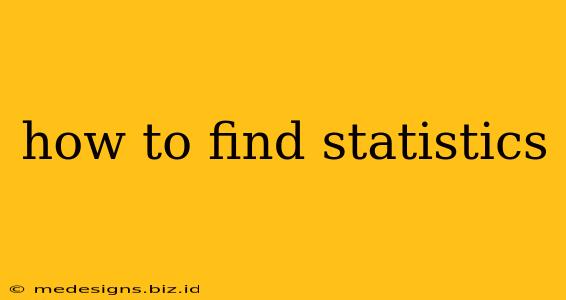Finding reliable statistics can be tricky. The internet is awash with data, but not all of it is accurate or relevant. This guide will walk you through the process of locating and evaluating statistical information, equipping you with the skills to become a savvy data detective.
Understanding Your Statistical Needs
Before you begin your search, it's crucial to define your needs precisely. Ask yourself:
- What specific topic are you researching? The more precise your topic, the easier it will be to find relevant statistics. Instead of searching for "economic data," try "unemployment rates in California 2023."
- What type of statistics do you need? Are you looking for percentages, averages, frequencies, or something else? Knowing this will help you filter your search results more effectively.
- What time period are you interested in? Statistics are often time-sensitive. Specify the years or months you want data for.
- What is your target audience? The level of detail and the source of your statistics will vary depending on who you're presenting the information to.
Reliable Sources for Statistics
Once you've clarified your needs, it's time to explore reputable sources:
Government Agencies:
Government agencies at national and international levels are goldmines of statistical information. Examples include:
- United States: The U.S. Census Bureau, the Bureau of Labor Statistics (BLS), and the National Center for Health Statistics (NCHS) provide a wealth of data on demographics, employment, health, and more.
- United Kingdom: The Office for National Statistics (ONS) offers comprehensive statistics on a wide range of topics.
- International: The World Bank, the International Monetary Fund (IMF), the United Nations (UN), and the World Health Organization (WHO) provide global statistics on various issues.
Pro Tip: Government websites often have detailed search functionalities, allowing you to filter data by region, time period, and other parameters.
Academic Databases:
Academic databases, such as JSTOR, Scopus, and Web of Science, contain research articles and studies that often include original statistical data. These databases require subscriptions in most cases, but access is usually available through universities and libraries.
Research Institutes and Think Tanks:
Organizations like the Pew Research Center, the Rand Corporation, and the Brookings Institution conduct extensive research and publish reports containing valuable statistical data. These organizations often have a particular focus, so be sure to choose one aligned with your research topic.
Reputable News Outlets:
While not always the primary source, reputable news organizations often cite statistics from credible sources in their reporting. However, always verify the source of the statistics mentioned in news articles before relying on them.
Evaluating the Reliability of Statistics
Once you've found some statistics, it's crucial to critically evaluate their reliability:
- Source Credibility: Is the source a recognized authority on the subject? Is it known for its objectivity and rigorous methodology?
- Methodology: How was the data collected? Was the sample size adequate? Was the methodology unbiased? Look for details on the data collection process.
- Data Transparency: Is the data clearly presented? Are the definitions of variables and measures clearly explained? Are there limitations or caveats mentioned?
- Potential Biases: Are there any potential biases that could affect the accuracy of the data? Consider the funding source and the potential motivations of the organization providing the statistics.
Tips for Effective Statistical Searches
- Use precise keywords: Avoid vague terms. The more specific your keywords, the better your search results will be.
- Use Boolean operators: Use words like "AND," "OR," and "NOT" to refine your searches.
- Explore different search engines: Don't rely on just one search engine. Experiment with different options, including specialized search engines for academic databases or government data.
- Check the dates: Ensure the statistics are current and relevant to your research.
- Cite your sources: Always properly cite the sources of your statistics to ensure transparency and allow others to verify your findings.
Finding accurate and reliable statistics takes time and effort, but by following these steps and practicing critical evaluation, you can significantly improve the quality of your research and analysis. Remember to always verify your findings from multiple reputable sources to avoid relying on potentially flawed or biased information.
